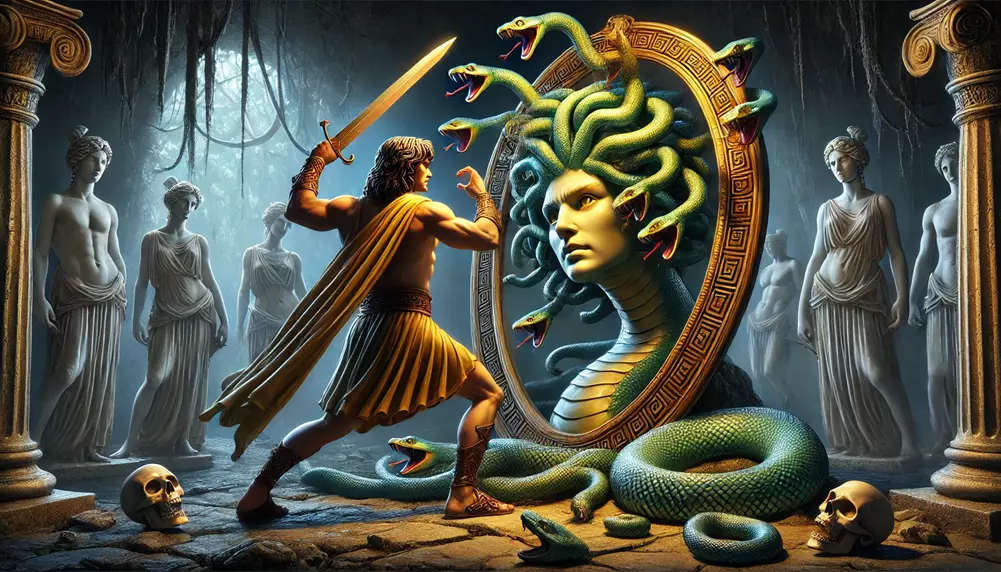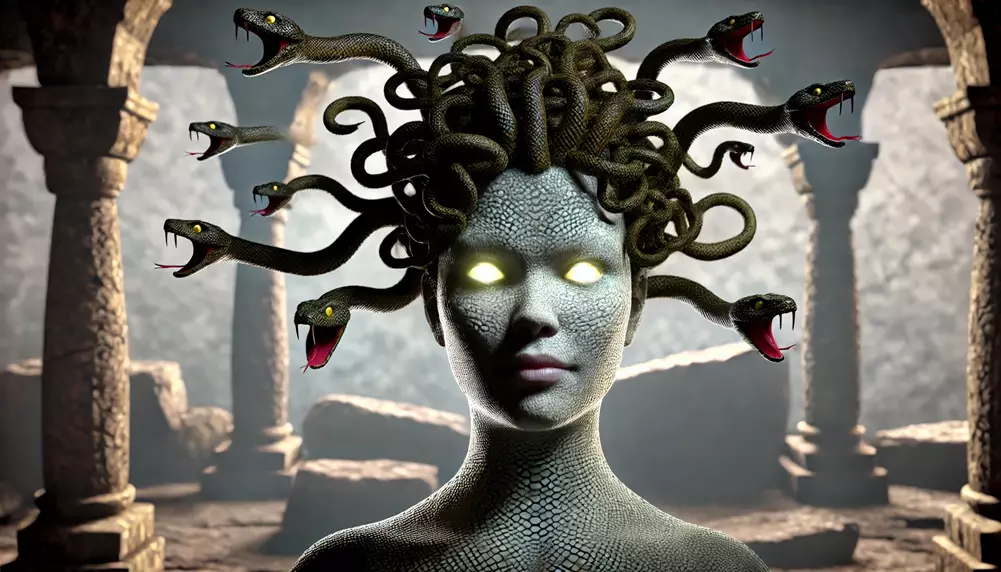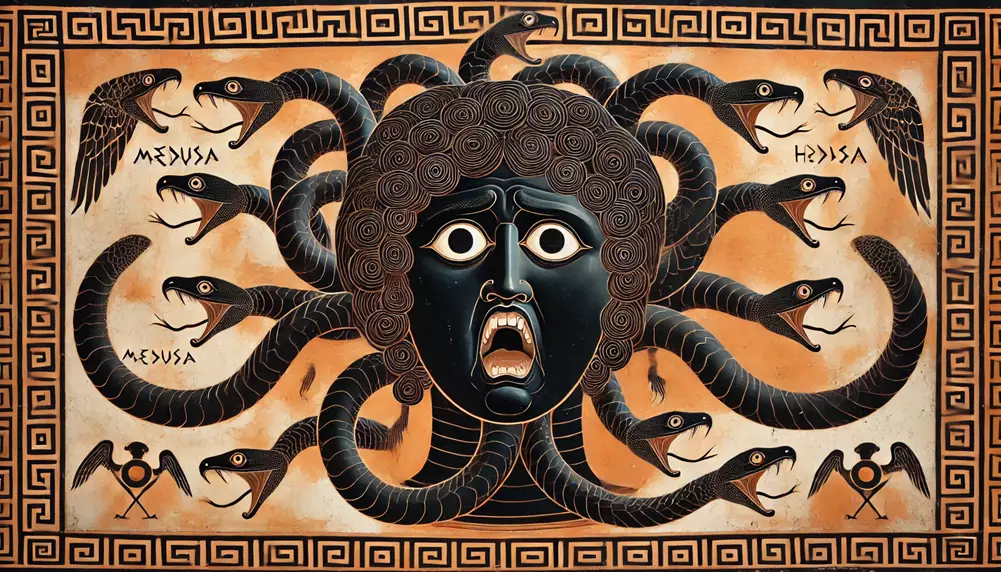Medusa is one of the most well-known figures in Greek mythology, famed for her snake-covered head and petrifying gaze. Once a beautiful woman, she was transformed into a monster as punishment, and her story has become emblematic of themes like beauty, betrayal, and revenge. She is often remembered as one of the Gorgons, cursed beings whose looks could turn mortals to stone. Over centuries, Medusa’s tale has been reinterpreted in various ways, reflecting shifting cultural attitudes towards power, femininity, and horror. Today, Medusa remains a compelling figure in popular culture, symbolizing both fear and fascination.
History/Origin
Medusa’s story originates in ancient Greek mythology and is most famously recounted in the works of poets such as Hesiod and Ovid. According to these sources, Medusa was once a beautiful maiden and a priestess of Athena. In some versions, she was known for her extraordinary beauty, particularly her hair, which drew the attention of Poseidon, god of the sea. One day, Poseidon pursued Medusa and violated her within Athena’s temple, an act that angered Athena. However, instead of punishing Poseidon, Athena took her wrath out on Medusa, transforming her into a monstrous creature. She was given serpentine hair, and her gaze became so powerful that it turned anyone who looked directly at her to stone.
In Hesiod’s Theogony, Medusa is described as one of the three Gorgon sisters, the only one who was mortal. Her sisters, Stheno and Euryale, were also monstrous, but they were immortal and shared similar terrifying features. Medusa’s mortal status made her particularly vulnerable, setting the stage for her eventual defeat at the hands of the hero Perseus.
The myth of Medusa evolved over time, with significant additions made by later Roman writers, especially Ovid in his Metamorphoses. In Ovid’s version, Medusa’s backstory as a wronged woman is expanded, eliciting some sympathy for her plight. While originally a straightforward monster, Medusa’s story began to be viewed through a more complex lens, portraying her as both a victim and a villain.
Name Meaning
The name “Medusa” is derived from the Ancient Greek word μέδω, meaning “to guard” or “to protect.” This etymology suggests an early association with guardianship, perhaps hinting at her later mythological role as a protector or symbol of defense. While her story has evolved into one of monstrous wrath, this original meaning has led some scholars to speculate about the protective elements associated with Medusa’s image, especially as her severed head later becomes a protective symbol used by Athena herself.
Background Story
The core myth involving Medusa revolves around her transformation, her isolation, and her eventual death. After being cursed by Athena, Medusa retreated to a distant island, where she lived alone, shunned by society due to her terrifying appearance. Her story culminates when the hero Perseus, tasked by King Polydectes, sets out to kill her. With the help of the gods, Perseus receives gifts that aid him in his quest: Hermes lends him winged sandals, Hades provides an invisibility helmet, and Athena gives him a reflective shield. These items are crucial in Perseus’ approach, allowing him to evade her petrifying gaze by looking only at her reflection in the shield.

In a fierce confrontation, Perseus beheads Medusa while she sleeps. From her blood sprang the winged horse Pegasus and the warrior Chrysaor, symbolizing Medusa’s lingering power even in death. Perseus then takes Medusa’s head back to Greece, using it as a weapon to turn his enemies into stone. Eventually, he offers it to Athena, who places it on her aegis as a symbol of her own power and protection. This portion of the myth emphasizes the complex duality of Medusa’s image as both destructive and protective.
Cultural Impact
In ancient Greek society, Medusa’s image was often used as a talisman. The “Gorgoneion,” or the depiction of Medusa’s head, was frequently used in art, shields, and armor as a protective symbol intended to ward off evil. Soldiers wore Gorgoneions on their shields, believing it would protect them in battle, while citizens would place Medusa’s likeness on doorways to repel malicious spirits. The image of Medusa thus became a powerful amulet, blending her terrifying visage with a sense of guardianship.
Medusa also played a significant role in Greek literature and philosophy. She was depicted as both a warning and a reflection of society’s views on beauty and femininity. Ancient playwrights and philosophers used her story to discuss the themes of vanity, jealousy, and divine justice. By the Hellenistic period, Medusa had become a symbol of complex femininity—both alluring and deadly.
In Roman times, Medusa’s influence continued to expand. Roman art depicted her more frequently, often emphasizing her tragic beauty and reinterpreting her as a figure of sorrow rather than just horror. This softer portrayal influenced Renaissance artists, who revived her image as an emblem of beauty corrupted by envy or lust. Renaissance artists like Leonardo da Vinci and Caravaggio famously painted her, with her face reflecting a haunting blend of beauty and terror.
Medusa also became associated with feminism, particularly in the late 20th and early 21st centuries. Feminist writers and artists began to view her story as a metaphor for the way women are punished for their beauty and autonomy. Her transformation from a beautiful maiden to a feared monster symbolized society’s fear and vilification of female power. Medusa’s image was reclaimed as an icon of female rage and resilience, inspiring artworks, literature, and feminist critiques.
Religion/Ritual
While not the subject of formal worship, Medusa’s image permeated religious and ritualistic practices in ancient Greece. The Gorgoneion became a common icon on temple pediments and sanctuaries, acting as a guardian symbol to protect sacred spaces. In some variations, Medusa is even linked to chthonic deities, representing both life and death due to her association with the underworld. Her role as a protective figure extended beyond military use to everyday household items and jewelry, reflecting her broad significance in both public and private life.
In modern times, Medusa’s image occasionally appears in neo-pagan rituals, where she is invoked as a figure of empowerment and protection. Though these are reinterpretations, they continue to draw on her historical legacy as a potent symbol with transformative and protective qualities.
Scientific & Rational Explanations
Scholars have offered various theories regarding the origin of Medusa’s myth. One popular theory suggests that Medusa may have been inspired by the real practice of using frightful images to ward off evil, a common tradition in ancient cultures. Some historians believe Medusa’s petrifying gaze could symbolize the fear that warriors felt in battle, with her image capturing the primal terror of facing death.
Other interpretations propose that Medusa’s monstrous appearance represents the archetypal “other,” embodying societal fears of the foreign or unknown. Anthropologists have compared her to similar figures in other mythologies, suggesting that she symbolizes the threat of chaos or untamed nature.
Some theories propose that Medusa’s story was influenced by early accounts of mental illness or physical disfigurement. Individuals with severe illnesses or injuries might have been viewed as monstrous or cursed, with their appearance inspiring myths of dangerous creatures. This rational approach highlights how ancient societies often used myth to explain physical and psychological phenomena that they did not fully understand.

In Modern Culture
Medusa’s influence has extended well beyond ancient myth and into various forms of modern media. She has become a popular character in literature, films, and video games, often depicted as a tragic figure or a powerful antagonist. In Percy Jackson & the Olympians, she appears as a villain whom the protagonist must confront, bringing her story into a contemporary fantasy setting. The film Clash of the Titans (both the 1981 original and the 2010 remake) famously features Medusa, emphasizing her as a creature of monstrous power and tragic beauty. These portrayals tend to focus on her monstrous aspects, with filmmakers often emphasizing the horror of her appearance and the danger of her gaze.
In literature, Medusa has been reinterpreted by feminist authors who see her as a symbol of female empowerment. Writers like Hélène Cixous have analyzed her as a figure who embodies the rage of women oppressed by patriarchal structures. In Cixous’ essay “The Laugh of the Medusa,” she encourages women to reclaim their voices and power, invoking Medusa as an icon of liberation. The essay has become a seminal work in feminist literature, inspiring further exploration of Medusa as a symbol of female rage and resilience.
Medusa has also appeared in comic books and graphic novels. In Marvel Comics, she is reimagined as a superhero, Medusalith Amaquelin, who can control her hair and use it as a weapon. This creative reinterpretation combines her mythological attributes with modern superhero themes, showcasing her as both powerful and complex.
Additionally, Medusa’s image has been adopted by the fashion industry, particularly by the Italian brand Versace, which uses the Gorgon’s head as its logo. The brand describes Medusa as symbolizing beauty, power, and seduction, aligning with the complex interplay of allure and danger that her myth represents. This usage illustrates how Medusa’s image continues to captivate and inspire, her story reinterpreted to align with contemporary ideals of beauty and strength.
Conclusion
Medusa’s legacy endures as a rich and multifaceted symbol. From her origins as a cautionary figure in Greek mythology to her modern interpretations as an icon of feminine strength, Medusa’s story reflects changing attitudes towards power, beauty, and gender. Her myth continues to resonate with audiences, revealing the timeless appeal of a character who embodies both horror and beauty. Medusa’s image, from ancient amulets to modern fashion logos, captures the enduring fascination with themes of transformation, fear, and resilience. Whether seen as a monster or a misunderstood figure, Medusa remains a potent symbol of the complexities of human nature and the enduring power of myth.










